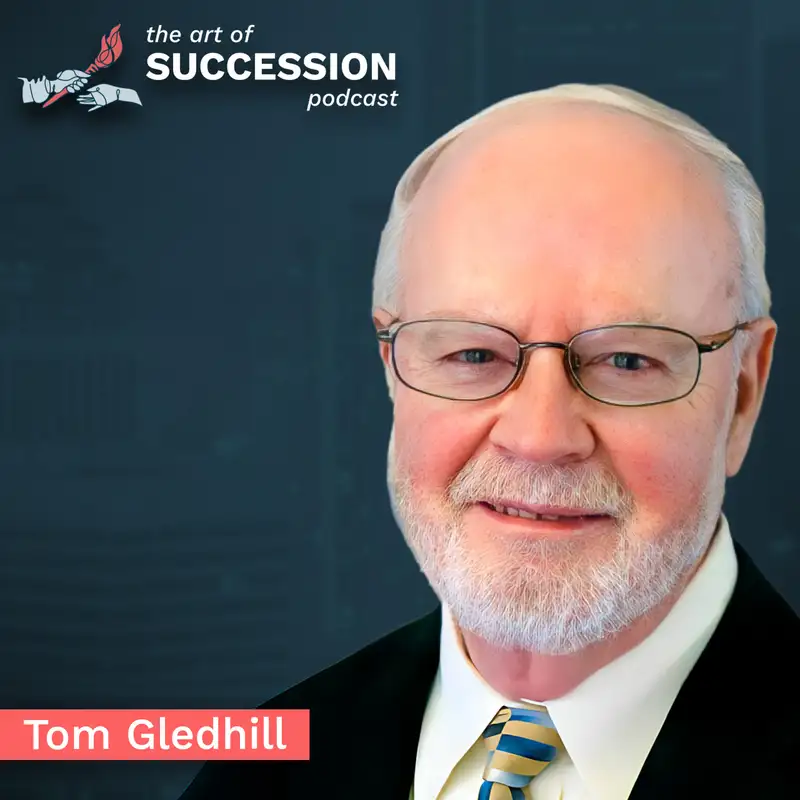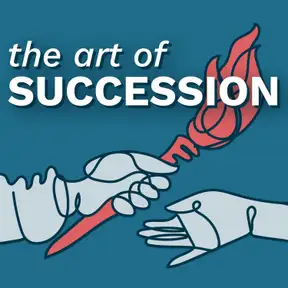Bridging the Valuation Gap: Building A Company Your Employees Want to Buy
In this episode of The Art of Succession podcast, host Barrett Young interviews Tom Gledhill, a former business owner, broker, and author who has successfully built and scaled four businesses. Listeners gain valuable insights into business scaling, valuation, and exit planning from his decades of experience spanning from early technology adoption to sophisticated exit strategies.
From Engineer to Software Entrepreneur
Tom shares his journey from electrical engineer to software entrepreneur in the healthcare industry during the 1970s, when computers were still large and uncommon. His company developed administrative software for outpatient clinics, facing initial challenges selling technology to medical practices unfamiliar with computers. Tom describes overcoming the "selling a rifle to a caveman" challenge through persistent cold calling and building referrals. The introduction of the IBM PC in 1980 was transformative, allowing smaller practices to afford their networked systems. By focusing on recurring revenue through maintenance contracts and continuously improving their product based on customer feedback, they eventually grew to 3,000 clients across the Northeast.
The Business Broker Perspective
After selling his software company (which was later acquired by a private equity group and eventually General Electric), Tom transitioned to business brokerage. During his first year, he spoke with nearly a thousand business owners, quickly learning that approximately 80% of businesses that go to market don't sell. Tom explains the common disconnect between what owners believe their businesses are worth versus market reality. Many owners base their valuation on what they need for retirement rather than what buyers are willing to pay—an "inside-out" perspective that leads to disappointment.
Creating Transferable Business Value
Tom distinguishes between different buyer types: corporations seek innovative systems and synergistic products; private equity groups want good management and recurring revenue; while lifestyle buyers look for businesses they can operate themselves. Creating a sellable business requires developing systems that can operate without the owner's constant involvement. Tom emphasizes that businesses heavily dependent on the owner's relationships or technical expertise are significantly less valuable. He recommends cleaning up financial statements, developing management teams, and creating documented processes that allow the business to run independently—ideally starting this preparation years before selling.
🎙️Full show notes, guest information, and video version of this episode available at https://gwcpas.com/blog/aos-tom-gledhill
✍️ Leave feedback for the show. I’d love to hear your input https://quark-fir-a64.notion.site/1d9dd04222f380ae96c9caae27bc1c66?pvs=105
The Art of Succession Podcast is brought to you by GWCPA. Twice a month on https://www.youtube.com/@gwcpas, CPA and Partner Barrett Young explores the emotional and strategic challenges of leadership transition, offering honest insights and actionable advice for successors and founders.
If you've enjoyed this episode, please share it with others. It truly helps.
Disclaimer: This podcast is for informational purposes only and does not constitute legal, tax, or accounting advice. You should consult your own advisors before making decisions related to your situation. If you don’t have an advisor yet, reach out!
From Engineer to Software Entrepreneur
Tom shares his journey from electrical engineer to software entrepreneur in the healthcare industry during the 1970s, when computers were still large and uncommon. His company developed administrative software for outpatient clinics, facing initial challenges selling technology to medical practices unfamiliar with computers. Tom describes overcoming the "selling a rifle to a caveman" challenge through persistent cold calling and building referrals. The introduction of the IBM PC in 1980 was transformative, allowing smaller practices to afford their networked systems. By focusing on recurring revenue through maintenance contracts and continuously improving their product based on customer feedback, they eventually grew to 3,000 clients across the Northeast.
The Business Broker Perspective
After selling his software company (which was later acquired by a private equity group and eventually General Electric), Tom transitioned to business brokerage. During his first year, he spoke with nearly a thousand business owners, quickly learning that approximately 80% of businesses that go to market don't sell. Tom explains the common disconnect between what owners believe their businesses are worth versus market reality. Many owners base their valuation on what they need for retirement rather than what buyers are willing to pay—an "inside-out" perspective that leads to disappointment.
Creating Transferable Business Value
Tom distinguishes between different buyer types: corporations seek innovative systems and synergistic products; private equity groups want good management and recurring revenue; while lifestyle buyers look for businesses they can operate themselves. Creating a sellable business requires developing systems that can operate without the owner's constant involvement. Tom emphasizes that businesses heavily dependent on the owner's relationships or technical expertise are significantly less valuable. He recommends cleaning up financial statements, developing management teams, and creating documented processes that allow the business to run independently—ideally starting this preparation years before selling.
🎙️Full show notes, guest information, and video version of this episode available at https://gwcpas.com/blog/aos-tom-gledhill
✍️ Leave feedback for the show. I’d love to hear your input https://quark-fir-a64.notion.site/1d9dd04222f380ae96c9caae27bc1c66?pvs=105
The Art of Succession Podcast is brought to you by GWCPA. Twice a month on https://www.youtube.com/@gwcpas, CPA and Partner Barrett Young explores the emotional and strategic challenges of leadership transition, offering honest insights and actionable advice for successors and founders.
If you've enjoyed this episode, please share it with others. It truly helps.
Disclaimer: This podcast is for informational purposes only and does not constitute legal, tax, or accounting advice. You should consult your own advisors before making decisions related to your situation. If you don’t have an advisor yet, reach out!

